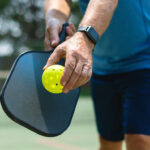Female participation in high school sports has gone up 900% since the passing of Title IX in 1972. Subsequently, we have seen a significant increase in the number of musculoskeletal injuries in female athletes. High school female athletes in the U.S. suffer between 20,000 and 80,000 ACL injuries per year. The anterior cruciate ligament (ACL) is one of 4 major ligaments that work to stabilize and support the knee. Female athletes are up to 8x more likely to suffer an ACL injury than males. An injury to the ACL occurs when the ligament is overstretched or torn due to sudden changes of direction, landing incorrectly, sudden stops, or direct contact with another player. Despite this, 70% of all ACL injuries occur without any physical contact. The cause is typically simple movements such as running, jumping, cutting, and landing improperly. The million dollar question is why are female athletes at such higher risk of tearing their ACL’s than their male counterparts? There are multiple factors including both physical difference and differences in technique that lead to this increased rate of injury.
Factors contributing to increased rates of ACL tears in female athletes:
-
The speed, power and intensity displayed by female athletes has dramatically increased over the past decade and a much more aggressive style of play has become the norm.
-
As girls enter puberty, their estrogen levels naturally increase adding more fat than muscle while ligaments become weaker.
-
Females have wider hips than males. This makes the angle between the hip and knee more significant placing more stress on the inside of the knee. This tends to lead to a more “knocked knee alignment” with the knee turning inward when landing. When the knee buckles, it places more stress on the ACL.
-
Females have a smaller groove in the knee, and because of this, have a smaller ligament which increases the risk of injury.
-
ACL injuries happen to girls that are in good shape. They happen because their movement patterns are not ideal.
-
Females run in a more upright position than males. This adds more stress to the ACL and less control over rotation of the knee.
-
Women tend to have an imbalance between the quadriceps and the hamstrings. Females are more likely to rely on their quadriceps to decelerate or change speed, placing more stress on the knee.
-
Women often land flat footed after a jump instead of on the balls of their feet. Improper landings lead to increased stress to the knee.
Despite these differences, there are exercises designed to strengthen the knee and prevent ACL injuries. Strength, coordination and stability of the knee is crucial in preventing knee injuries in female athletes. Strengthening the quadriceps, hamstrings, and gluteal muscles regularly have been found to have a significant effect on reducing the incidents of ACL injuries.
Warm Up:
-
Straight Line Jogging (1 minute): Keeping hips, knees, and feet pointed straight ahead.
-
Side shuffle (1 minute): Shuffle side to side for 1 minute.
-
Backward Jogging (1 minute): Keep knees bent slightly at all times. Should be landing on your toes.
Stretching: 30 Second Hold x 2 Reps Each Leg
-
Calf Stretch (classic runner’s stretch): Stand leading with right knee bent. Keep left heel on the ground and lean forward until a stretch is felt in the left calf. Repeat on opposite side.
-
Quad Stretch: While standing, reach back and grab one ankle, and pull that ankle to your buttocks. Your knee should point straight down and stay close to opposite leg. Repeat on opposite side.
-
Figure 4 Hamstring Stretch: Sit with right leg straight out in front. Bend left knee and place bottom of left foot on right inner thigh. Keeping back straight, push chest forward towards right knee. Repeat on opposite side.
-
Inner thigh Stretch: Sit with legs straight and evenly spread. Keep the back straight, stretch to the center and then toward each foot.
-
Hip Flexor Stretch: Lunge forward with right leg and drop left knee to ground. Keeping back straight, lean forward with hips, keeping hips and shoulders pointing forward. If possible, pull left ankle to buttocks. Repeat on opposite side.
Strengthening: 1-2 minutes of each
-
Walking Lunge: Lunge forward leading with right leg. Push off right leg and lunge forward with left leg. Maintain knee and toes pointing straight.
-
Russian Hamstring: Kneel on the ground with back straight and ankles firmly held by a partner. Keep back and hips in line while slowly leaning forward, as far as, possible and then returning to the start position.
-
Single Leg Calf Raise: Stand on one leg and slowly raise up on toes. Repeat on opposite side.
-
Single Leg Squat: Stand on one leg. Keep chest up and squat down. Keep knee and toes straight and keep your knee behind your foot.
-
Half Kneeling Chop and Lift: Lunge forward with right knee letting left knee rest on ground. Holding a medicine ball or weight lift up over right shoulder then down to left hip. Repeat on opposite side with left leg forward.
-
Planks: Lie on floor. Lift hips up off floor so only toes and elbows are touching the ground. Keep core tight and body in a straight line.
Plyometrics – 30 Seconds of Each
Focus on landing softly on balls of feet with knees bent.
-
Lateral Hops over Cone: Stand with a cone on one side. Hop sideways back and forth over the cone.
-
Forward/Backwards Hops over Cone: Stand with a cone in front. Hop forward over the cone and then backwards over the cone.
-
Single Leg Hops over Cone: Repeat above exercises standing on one leg. Perform on both legs.
-
Vertical Jumps with Squat: Stand with hands at side. Squat down and jump straight up. Land softly on balls of feet and do not allow your knees to cave inward.
-
Scissor Jumps (lunge jumps): Lunge forward with right leg keeping knee over ankle. Push off right foot and bring left leg forward into lunge position. Do not let forward knee cave in our out.
Agility – 2 times each
Lay out 3-6 cones a minimum of 20 feet apart
-
Forward/Backward Running – Cones in Straight Line: Start at first cone and sprint forward. Use a quick 3 step stop before you reach the second cone. Continue through the rest of the cones in the same manner. Repeat facing backwards. Do not let knees go past toes or cave inwards.
-
Diagonal Runs – (Cones at an angle from each other): Sprint forward to first cone on right. Pivot off right foot and push off to sprint to cone on left. Alternate cones on each side.
-
Bounding Run: (2 Cones 40-50 yards apart). Run between cones bringing knees as high as you can. Land on balls of feet keeping knee in line with ankle.




